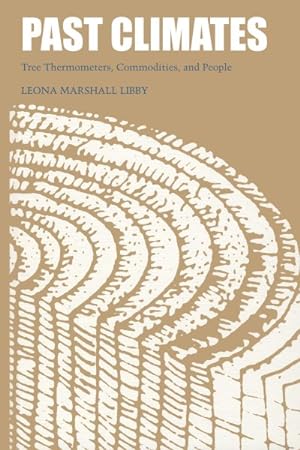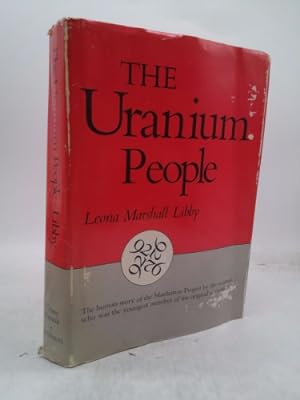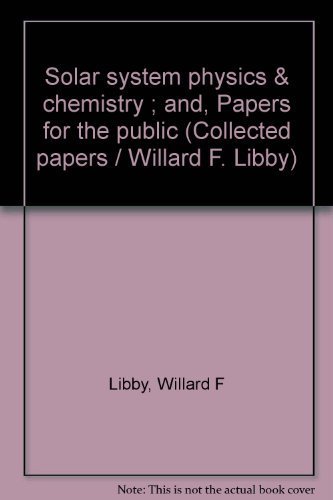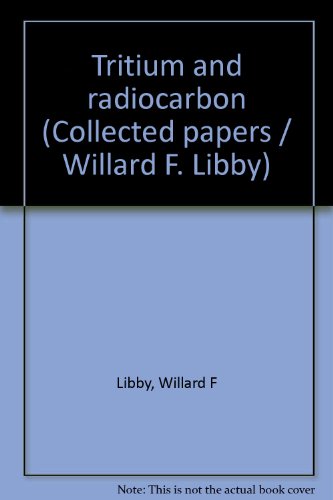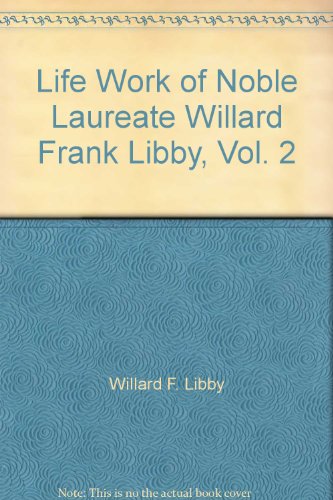Libby Leona (45 results)
Product Type
- All Product Types
- Books (44)
- Magazines & Periodicals (1)
- Comics
- Sheet Music
- Art, Prints & Posters
- Photographs
- Maps
-
Manuscripts &
Paper Collectibles
Condition
Binding
Collectible Attributes
Free Shipping
Seller Location
Seller Rating
-
MULTIPLE THERMOMETRY IN PALEOCLIMATE AND HISTORIC CLIMATE
Published by J Geophysical Research, 1972
Seller: Larry W Price Books, Portland, OR, U.S.A.
Magazine / Periodical
Pamphlet. Condition: Very Good. Vol 77, No 23, pp. 4310-4317, Extracted from orig vol, begins with title page, stapled & trimmed, thus is like a pamphlet, VG.
-
Past Climates : Tree Thermometers, Commodities, and People
Published by University of Texas Press, 1983
ISBN 10: 0292741294ISBN 13: 9780292741294
Seller: GreatBookPrices, Columbia, MD, U.S.A.
Book
Condition: New.
More buying choices from other sellers on AbeBooks
New offers from US$ 24.64
Used offers from US$ 28.73
Also find Softcover
-
Past Climates : Tree Thermometers, Commodities, and People
Published by University of Texas Press, 1983
ISBN 10: 0292730195ISBN 13: 9780292730199
Seller: Better World Books: West, Reno, NV, U.S.A.
Book
Condition: Good. Former library book; may include library markings. Used book that is in clean, average condition without any missing pages.
More buying choices from other sellers on AbeBooks
Used offers from US$ 29.20
Also find First Edition
-
The Uranium People
Published by Crane, Russak, 1979
ISBN 10: 0844813001ISBN 13: 9780844813004
Seller: HPB-Red, Dallas, TX, U.S.A.
Book
hardcover. Condition: Good. Connecting readers with great books since 1972! Used textbooks may not include companion materials such as access codes, etc. May have some wear or writing/highlighting. We ship orders daily and Customer Service is our top priority!.
More buying choices from other sellers on AbeBooks
New offers from US$ 143.50
Used offers from US$ 39.94
Also find Hardcover First Edition
-
Solar System Physics & Chemistry Papers For The Public (Willard F. Libby Collected Papers Volumes V & VI
Published by Geo Science Analytical Inc., 1981
Seller: Voltaire and Rousseau Bookshop, Glasgow, United Kingdom
Book
Soft cover. Condition: Good. No Jacket. (Ref. ) Volume V & VI bound together. Some light shelfwear to covers. Outer edges have one or two scuffs and marks else main contents are very good and unmarked. **Heavy volume may be extra postage. Please message for details.**.
-
The Uranium People
Published by Bookthrift, 1979
ISBN 10: 0684162423ISBN 13: 9780684162423
Seller: ThriftBooksVintage, Tukwila, WA, U.S.A.
Book
Hardcover. Condition: Good. No Jacket. Shelf and handling wear to cover and binding, with general signs of previous use. Wear commensurate with age and use. Annotations and underlining in pencil throughout text. Slight spine lean. Dust jacket wrapped in protective mylar sleeve. Secure packaging for safe delivery. 1.9.
More buying choices from other sellers on AbeBooks
Used offers from US$ 77.00
Also find First Edition
-
The Uranium People
Published by Crane, Russak, 1979
ISBN 10: 0844813001ISBN 13: 9780844813004
Book First Edition
Condition: Good. NY: Crane Russak and Charles Scribner's Sons, 1979. 1st edition. Sm 4to Hardcover. 341pp. B/W photos. Near Very Good book and Acceptable dust jacket. (history, science, physics, atomic bomb) Inquire if you need further information.
-
Collected Papers; Volume VII, Talking to People
Published by Geo Science Analytical, Inc. and University of California at Los Angeles, Santa Monica, CA and Los Angeles, CA, 1981
ISBN 10: 0941054071ISBN 13: 9780941054072
Seller: Ground Zero Books, Ltd., Silver Spring, MD, U.S.A.
Book First Edition
Trade paperback. Condition: Good. Presumed First Edition, First printing. Various paginations (approximately 1 inch thick). Footnotes. Figures. Tables. References. Ex-Los Alamos National Laboratory library with usual library markings. This collection of W. F. Libby's papers contains those on Talking to People. This includes a two page entry entitled Recollections of a Long and Fruitful Friendship by Edward Teller. The contents of this volume are talks that existed as typed, double-spaced papers in Bill Libby's files, but for the most part were no published in the open literature. A few of the papers are exceedingly technical but are included here because Dr. Libby withheld them from publication; no doubt intending to rethink them if more information should become available. Many of the papers are talks given at every lever, e.g. high schools, colleges, business organizations, journalists, and various groups. All were written between 1960 and 1980. Among the topics covered are: The Role of the Chemist in Atomic Power, The Citizen and the Atom, Nobel Award Acceptance Speech, Radiocarbon Dating, Civil Defense, Tritium Geophysics, Atomic Armaments, Radioactive Fallout, Fallout Shelter, The Atomic Space Ship, Nuclear Energy, Plowshare, Space Science, Gasbuggy Site, Solar Wind, Venus Orbiters, Climate History, and Spent Oil Fields. Willard Frank Libby (December 17, 1908 - September 8, 1980) was an American physical chemist noted for his role in the 1949 development of radiocarbon dating, a process which revolutionized archaeology and paleontology. For his contributions to the team that developed this process, Libby was awarded the Nobel Prize in Chemistry in 1960. A 1931 chemistry graduate of the University of California, Berkeley, from which he received his doctorate in 1933, he studied radioactive elements and developed sensitive Geiger counters to measure weak natural and artificial radioactivity. During World War II he worked in the Manhattan Project's Substitute Alloy Materials (SAM) Laboratories at Columbia University, developing the gaseous diffusion process for uranium enrichment. After the war, Libby accepted professorship at the University of Chicago's Institute for Nuclear Studies, where he developed the technique for dating organic compounds using carbon-14. He also discovered that tritium similarly could be used for dating water, and therefore wine. In 1950, he became a member of the General Advisory Committee (GAC) of the Atomic Energy Commission (AEC). He was appointed a commissioner in 1954, becoming its sole scientist. He sided with Edward Teller on pursuing a crash program to develop the hydrogen bomb, participated in the Atoms for Peace program, and defended the administration's atmospheric nuclear testing. Libby resigned from the AEC in 1959 to become Professor of Chemistry at University of California, Los Angeles (UCLA), a position he held until his retirement in 1976. In 1962, he became the Director of the University of California statewide Institute of Geophysics and Planetary Physics (IGPP).
-
Collected Papers; Volumes V & VI, Solar System Physics & Chemistry and Papers for the Public
Published by Geo Science Analytical, Inc. and University of California at Los Angeles, Santa Monica, CA and Los Angeles, CA, 1981
ISBN 10: 0941054055ISBN 13: 9780941054058
Seller: Ground Zero Books, Ltd., Silver Spring, MD, U.S.A.
Book First Edition
Trade paperback. Condition: Good. Presumed First Edition, First printing. Various paginations (approximately 1.5 inches thick). Footnotes. Figures. Tables. References. Ex-Los Alamos National Laboratory library with usual library markings. This collection of W. F. Libby's papers contains those on Solar System Physics and Chemistry, and Papers for the Public. Among the topics addressed include: Jupiter's Radio Emission, Free Radicals, Ice Caps on Venus, Jupiter Decametric Radiation, Solar Wind, Vegetative Life on Venus, Meteorite Carbon, Planetary Atmospheres, Radioactive Fallout, Astronauts, and Radioisotopes Willard Frank Libby (December 17, 1908 - September 8, 1980) was an American physical chemist noted for his role in the 1949 development of radiocarbon dating, a process which revolutionized archaeology and paleontology. For his contributions to the team that developed this process, Libby was awarded the Nobel Prize in Chemistry in 1960. A 1931 chemistry graduate of the University of California, Berkeley, from which he received his doctorate in 1933, he studied radioactive elements and developed sensitive Geiger counters to measure weak natural and artificial radioactivity. During World War II he worked in the Manhattan Project's Substitute Alloy Materials (SAM) Laboratories at Columbia University, developing the gaseous diffusion process for uranium enrichment. After the war, Libby accepted professorship at the University of Chicago's Institute for Nuclear Studies, where he developed the technique for dating organic compounds using carbon-14. He also discovered that tritium similarly could be used for dating water, and therefore wine. In 1950, he became a member of the General Advisory Committee (GAC) of the Atomic Energy Commission (AEC). He was appointed a commissioner in 1954, becoming its sole scientist. He sided with Edward Teller on pursuing a crash program to develop the hydrogen bomb, participated in the Atoms for Peace program, and defended the administration's atmospheric nuclear testing. Libby resigned from the AEC in 1959 to become Professor of Chemistry at University of California, Los Angeles (UCLA), a position he held until his retirement in 1976. In 1962, he became the Director of the University of California statewide Institute of Geophysics and Planetary Physics (IGPP).
-
Collected Papers; Volume I, Tritium and Radiocarbon
Published by Geo Science Analytical, Inc, Santa Monica, CA, 1981
ISBN 10: 0941054012ISBN 13: 9780941054010
Seller: Ground Zero Books, Ltd., Silver Spring, MD, U.S.A.
Book First Edition
Trade paperback. Condition: Good. Presumed First Edition, First printing. Various paginations (640 pages per bibliographic reference). Footnotes. Figures. Tables. References. Ex-Los Alamos National Laboratory with usual library markings. Back cover tear. This collection of W. F. Libby's papers contains all those on Radiocarbon and Tritium Dating and Tracing. The papers are introduced briefly by either a collaborator or the editors. After the war, Libby accepted an offer from the University of Chicago of a professorship in the Chemistry Department at the new Institute for Nuclear Studies. He returned to his studies of radioactivity. In 1939, Serge Korff had discovered that cosmic rays generated neutrons in the upper atmosphere. These interact with nitrogen-14 in the air to produce carbon-14: 1n + 14N 14C + 1p. The half-life of carbon-14 is 5,730±40 years. Libby realized that when plants and animals die they cease to ingest fresh carbon-14, thereby giving any organic compound a built-in nuclear clock. He published his theory in 1946 and expanded on it in his monograph Radiocarbon Dating in 1955. He also developed sensitive radiation detectors that could use the technique. Tests against sequoia with known dates from their tree rings showed radiocarbon dating to be reliable and accurate. The technique revolutionized archaeology, paleontology and other disciplines that dealt with ancient artifacts. In 1960, he was awarded the Nobel Prize in Chemistry "for his method to use carbon-14 for age determination in archaeology, geology, geophysics, and other branches of science". He also discovered that tritium similarly could be used for dating water, and therefore wine. Willard Frank Libby (December 17, 1908 - September 8, 1980) was an American physical chemist noted for his role in the 1949 development of radiocarbon dating, a process which revolutionized archaeology and paleontology. For his contributions to the team that developed this process, Libby was awarded the Nobel Prize in Chemistry in 1960. A 1931 chemistry graduate of the University of California, Berkeley, from which he received his doctorate in 1933, he studied radioactive elements and developed sensitive Geiger counters to measure weak natural and artificial radioactivity. During World War II he worked in the Manhattan Project's Substitute Alloy Materials (SAM) Laboratories at Columbia University, developing the gaseous diffusion process for uranium enrichment. After the war, Libby accepted professorship at the University of Chicago's Institute for Nuclear Studies, where he developed the technique for dating organic compounds using carbon-14. He also discovered that tritium similarly could be used for dating water, and therefore wine. In 1950, he became a member of the General Advisory Committee (GAC) of the Atomic Energy Commission (AEC). He was appointed a commissioner in 1954, becoming its sole scientist. He sided with Edward Teller on pursuing a crash program to develop the hydrogen bomb, participated in the Atoms for Peace program, and defended the administration's atmospheric nuclear testing. Libby resigned from the AEC in 1959 to become Professor of Chemistry at University of California, Los Angeles (UCLA), a position he held until his retirement in 1976. In 1962, he became the Director of the University of California statewide Institute of Geophysics and Planetary Physics (IGPP).
-
Collected Papers; Volume II, Radiochemistry, Hot Atoms & Physical Chemistry
Published by Geo Science Analytical, Inc. and University of California at Los Angeles, Santa Monica, CA and Los Angeles, CA, 1981
ISBN 10: 0941054020ISBN 13: 9780941054027
Seller: Ground Zero Books, Ltd., Silver Spring, MD, U.S.A.
Book First Edition
Trade paperback. Condition: Good. Presumed First Edition, First printing. Various paginations (400 pages per bibliographic reference). Footnotes. Figures. Tables. References. Ex-Los Alamos National Laboratory library with usual library markings. This collection of W. F. Libby's papers contains those on Radiochemistry, Hot Atoms, namely the chemistry of atoms, ions, radicals, ligands, and chemical entities excited to energies far beyond those commonly tested at ordinary temperatures. This volume also contains important papers about synthetic metals, synthetic catalysts to replace platinum and platinum group metals, and synthetic superconductors, with the promise and possibility of new synthetic superconductors solving the hopes to discover superconductors at temperatures far above that of liquid hydrogen. This includes a two page write-up by W. G. McMillan on Willard Libby and the Manhattan Project and a five page letter from John A. McCone to Mrs. Leona Libby on Dr. Libby's service to the Atomic Energy Commission. Willard Frank Libby (December 17, 1908 - September 8, 1980) was an American physical chemist noted for his role in the 1949 development of radiocarbon dating, a process which revolutionized archaeology and paleontology. For his contributions to the team that developed this process, Libby was awarded the Nobel Prize in Chemistry in 1960. A 1931 chemistry graduate of the University of California, Berkeley, from which he received his doctorate in 1933, he studied radioactive elements and developed sensitive Geiger counters to measure weak natural and artificial radioactivity. During World War II he worked in the Manhattan Project's Substitute Alloy Materials (SAM) Laboratories at Columbia University, developing the gaseous diffusion process for uranium enrichment. After the war, Libby accepted professorship at the University of Chicago's Institute for Nuclear Studies, where he developed the technique for dating organic compounds using carbon-14. He also discovered that tritium similarly could be used for dating water, and therefore wine. In 1950, he became a member of the General Advisory Committee (GAC) of the Atomic Energy Commission (AEC). He was appointed a commissioner in 1954, becoming its sole scientist. He sided with Edward Teller on pursuing a crash program to develop the hydrogen bomb, participated in the Atoms for Peace program, and defended the administration's atmospheric nuclear testing. Libby resigned from the AEC in 1959 to become Professor of Chemistry at University of California, Los Angeles (UCLA), a position he held until his retirement in 1976. In 1962, he became the Director of the University of California statewide Institute of Geophysics and Planetary Physics (IGPP).
-
Willard F. Libby: Collected Papers (The Publications of Willard Frank Libby in 7 Volumes:
Published by Geo Science Analytical/UCLA, 1981
Seller: Silent Way Books, Glenside, PA, U.S.A.
Book
Oversized Paperbacks. Condition: Very Good. 5 books encompassing 7 volumes: Radiocarbon & Tritium; Radiochemistry, Hot Atoms & Physical Chemistry; Radioactivity, Particle Physics/Radioactive Fallout & Technology; Solar System Physics & Chemistry Papers For the Public; Talking to People. All in very solid, unmarked condition. Vols. 1 & 2 have lightly creased spines but bindings are firm. Very little wear to report otherwise. International shipping will require additional postage due to bulk.



